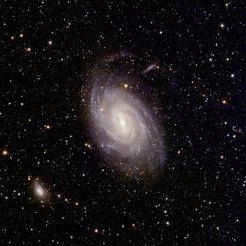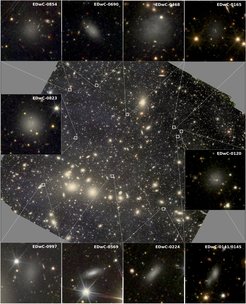ESA's Euclid celebrates first science with sparkling cosmic views
Analysis of the early release observations provides insights into the evolution of the Perseus galaxy cluster
Today, ESA’s Euclid space mission releases five unprecedented new views of the Universe. The never-before-seen images demonstrate Euclid’s ability to unravel the secrets of the cosmos and enable scientists to hunt for rogue planets, use lensed galaxies to study mysterious matter, and explore the evolution of the Universe. The new images accompany the mission’s first scientific data, also made public today, and several science papers, including one led by the Max Planck Institute for Extraterrestrial Physics in Garching, with an unprecedented analysis of the faint intra-cluster light of the Perseus cluster of galaxies.

The full set of Euclid’s early observations targeted 17 astronomical objects, from nearby clouds of gas and dust to distant clusters of galaxies, ahead of Euclid’s main survey. Euclid will trace the hidden web-like foundations of the cosmos, map billions of galaxies across more than one-third of the sky, explore how our Universe formed and evolved over cosmic history, and study the most mysterious of its fundamental components: dark energy and dark matter.
While visually stunning, the images are far more than beautiful snapshots; they reveal new physical properties of the Universe thanks to Euclid’s novel and unique observing capabilities. These scientific secrets are detailed further in a number of accompanying papers released by the Euclid collaboration, together with five key reference papers about the Euclid mission (see link to the ESA press release on the left). Euclid produced this early catalogue in just a single day, revealing over 11 million objects in visible light and 5 million more in infrared light.
Euclid’s image of the Perseus cluster of galaxies was published as one of the first images of the space telescope, just six months ago. Perseus is one of the most spectacular objects in our cosmic neighborhood: It is located at a distance of “only” 240 million light years (at a redshift of z = 0.018) and is the brightest X-ray cluster. With its high total mass of 650 trillion solar masses, its gravity ties thousands of galaxies together.

For the first time, a team led by the Max Planck Institute for Extraterrestrial Physics (MPE) has now been able to analyze the diffuse light from the Perseus galaxy cluster to far-out regions. “The high sensitivity at optical and near-infrared wavelengths over a huge field of view allows us to capture the extended faint light in the Perseus cluster,” says Matthias Kluge, lead author of the study, which is now being published together with 14 other papers. “This light is more than 100,000 times fainter in the infrared than the darkest night sky on Earth. Nevertheless, due to its large volume, it accounts for about 20% of the luminosity of the entire cluster.”
In addition, the team also used Euclid's excellent visible light imaging capabilities - comparable to the Hubble Space Telescope - to detect 50,000 free-flying globular clusters. The characteristics of the globular clusters and the bluish color of the diffuse light indicate their common origin: On the one hand, they originate from the low-metallicity outer regions of massive cluster galaxies that have been stripped away by the tidal forces of the cluster. On the other hand, there is an increasing contribution of dwarf galaxies, which were also completely torn apart by the strong tidal forces, with increasing distance from the cluster center.

In a further study, numerous surviving dwarf galaxies were detected in the Perseus cluster. Raphael Zöller from MPE and LMU was significantly involved in the measurements: “Euclid is located at the second Lagrange point far outside the Earth's atmosphere. Thanks to the dark image background, the excellent image resolution and the large field of view, we were able to detect 1100 dwarf galaxies, including hundreds with much fainter luminosity than ever before in the Perseus galaxy cluster.”
Background information
Euclid is a space mission of the European Space Agency (ESA) with contributions from the National Aeronautics and Space Administration (NASA). It is the second M-class mission in ESA's Cosmic Vision programme.
VIS and NISP were developed and built by a consortium of scientists and engineers from 17 countries, many from Europe, but also from the USA, Canada and Japan. From Germany, the Max Planck Institute for Astronomy (MPIA) in Heidelberg, the Max Planck Institute for Extraterrestrial Physics (MPE) in Garching, the Ludwig Maximilian University (LMU) in Munich, the University of Bonn (UB), the Ruhr University Bochum (RUB) and the German Space Agency at the German Aerospace Centre (DLR) in Bonn are participating. As partner of the Euclid project, MPE is responsible for the optical components of the NISP instrument as well as for the optical design and modelling of the image quality and is hosting one of Euclid's nine Science Data Centers.
The German Space Agency at DLR coordinates the German ESA contributions and also provides funding of 60 million euros from the National Space Programme for the participating German research institutes.
With around 21%, Germany is the largest contributor to the ESA science programme.














